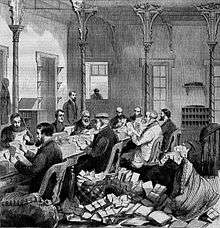Dead letter office

A dead letter office (DLO) is a facility within a postal system where undeliverable mail is dealt with.[1] Mail is considered to be undeliverable when the address is invalid so it cannot be delivered to addressee, and there is no return address so it cannot be returned to the sender.
At a DLO, mail is usually opened to try to find an address to forward to. If an address is found, the envelope is usually sealed using tape or postal seals, or enclosed in plastic bags and delivered.[2] If the letter or parcel is still undeliverable, valuable items are then auctioned off while the correspondence is usually destroyed. Despite this practice, in the past some undeliverable envelopes were acquired by philatelists.[3]
Dead letter offices go by different names in different countries. Other names include returned letter office or undeliverable mail office.
Canada
Canada Post sends mail which is not deliverable to the Undeliverable Mail Office (NUMO) at Mississauga, Ontario[4] or North Sydney, Nova Scotia. Domestic mail which is still undeliverable after passing through NUMO is then destroyed, while incoming international undeliverable mail is returned to the country of origin.[3]
Malta
In Malta, undeliverable mail was sorted in the General Post Office in Valletta. The facility was initially known as Returned Letter Branch, but later on it was also referred to as Returned Letter Office or Dead Letter Office. Various postal markings were used at the facility from 1889 onwards.[5]
United Kingdom
A Dead Letter Office was first established in 1784 for dead and missent letters that had reached London. The bye-letter offices dealt with bye-letters and those that did not go to London. No postage was charged for returns, which were made after six months, where an addressee was found. From 1790 a charge was made for returned letter but the time was reduced to two months by John Palmer. Upon hearing of the return charge William Pitt rescinded the charge.[6]
In the UK, undeliverable mail is processed in the National Returns Centre in Belfast[7] which holds 20 million undeliverable items,[8] or in a smaller office in Portsmouth.[9]
United States
The United States Postal Service started a dead letter office in 1825 to deal with undeliverable mail. By 1893, it handled about 20,000 items every day.[3] In 2006 approximately 90 million undeliverable-as-addressed (UAA) items ended up in this office; where the rightful owners cannot be identified, the correspondence is destroyed to protect customer privacy, and enclosed items of value are removed.[10] Items of value that cannot be returned are sold at auction, except for pornography and firearms. The auctions also occasionally include items seized by postal inspectors and property being retired from postal service.
These facilities are now known as mail recovery centers (MRC). Other former names include dead letter branch and dead parcel branch. The USPS mail recovery center is located in Atlanta, Georgia. Since April 2013, the postal auctions have been held online and include not only material lost in the U.S. but also material from other national postal authorities who consign them to the USPS for auction.[11]
In popular culture

- One famous fictional alleged employee of the dead letter office is Bartleby, the eponymous character of Herman Melville's "Bartleby, the Scrivener: A Story of Wall-Street".[12]
- Alternative rock band R.E.M. released a compilation of B-sides and rarities entitled Dead Letter Office.
- In the 1947 film Miracle on 34th Street, two mail sorters handle a letter addressed to "Kris Kringle" at the New York City courthouse, and decide to deliver all the Santa Claus mail now in the dead letter office to the courthouse, where a man calling himself Kris Kringle is facing a mental competency hearing. The man's attorney uses the huge volume of mail as evidence that the federal government recognizes his client as "the one-and-only Santa Claus."[13]
- Horror writer Clive Barker's book The Great and Secret Show features segments centered around the dead letter office at Omaha, Nebraska.[14]
- In The Simpsons episode "Sunday, Cruddy Sunday", Springfield Elementary School visits their local Post Office and are treated to a piece of undeliverable mail from the dead letter office as a souvenir.[15]
- In the 1996 comedy film Dear God, a character played by Greg Kinnear, who works in the dead letter office at Los Angeles, CA, responds to letters written to God.[16]
- The 2014 television series Signed, Sealed, Delivered takes place in a fictional Dead Letter Office in Denver, Colorado[17]
- Terry Pratchett's Discworld novel Going Postal takes place in a post office. At one point, Moist von Lipwig, the novel's protagonist, takes it upon himself to track down the intended recipients of as many dead letters as possible.
- The Bones episode "The Male in the Mail" (season 7, episode 4) featured a decomposed body turning up at the dead letter office in Washington D.C.[18]
References
- ↑ Patrick, Douglas & Mary (1973). The Musson Stamp Dictionary. Toronto: Musson Book Company. p. 64. ISBN 0773700064.
- ↑ Hirn, Todd A. "Officially Sealed Mails of the World". poseal.com. Retrieved 21 March 2015.
- 1 2 3 Miller, Rick. "Dead letter office gave rise to official seals". Linns.com. Retrieved 21 March 2015.
- ↑ Lu, Vanessa (29 September 2011). "Ever lose anything in the mail? Here's where it all ends up". Toronto Star. Retrieved 28 August 2012.
- ↑ Proud, Edward B. (1999). The Postal History of Malta. Heathfield: Proud-Bailey Co. Ltd. p. 250. ISBN 1872465315.
- ↑ Joyce, Herbert (1893). The History of the Post Office from its establishment down to 1836. London: Richard Bentley & Sons. pp. 307–308.
- ↑ "What happens next when we can't deliver your mail". Royal Mail. 2015. Retrieved 22 March 2015.
- ↑ Mayll, Steve (13 February 2013). "The lost post: Secrets of the warehouse where 20 MILLION undelivered items have ended up". UK News. Daily Mirror. Retrieved 22 March 2015.
- ↑ Mann, Natasha (27 January 2003). "People send the funniest things". The Guardian. Retrieved 21 March 2015.
- ↑ "2006 Comprehensive Statement". USPS. 2006. Archived from the original on 9 May 2009. Retrieved 25 March 2009.
- ↑ Malloy, Daniel (7 March 2013). "Post Office moving Atlanta unclaimed mail auction online". Atlanta Journal-Constitution. Retrieved 30 December 2013.
- ↑ "Pushing Paper". Lapham's Quarterly. 18 March 2011. Retrieved 7 September 2016.
- ↑ Carr, Kevin (16 December 2013). "Could the U.S. Post Office Really Help Prove Santa Exists, Like in 'Miracle on 34th Street'?". Film School Rejects. Retrieved 21 May 2014.
- ↑ "The Complete Clive Barker's The Great and Secret Show". Literal Remains. 8 September 2010. Archived from the original on 7 September 2016. Retrieved 21 May 2014.
- ↑ "Script - Sunday, Cruddy Sunday". Retrieved 17 July 2014.
- ↑ Maslin, Janet (1 November 1996). "Movie Review: Dear God (1996) Where Do Dead Letters Go? Heaven". New York Times. Retrieved 21 May 2014.
- ↑ "Martha Williamson Begins a Highly Anticipated Return to Television with "Dead Letters," (Working Title) a Hallmark Channel Original Movie of the Week and Potential New Primetime Series". The Futon Critic. July 2, 2013. Retrieved April 14, 2014.
- ↑ "The Male in the Mail". TV.com. 1 December 2011. Retrieved 12 June 2014.
External links
- Dead Letter Office Smithsonian Arago — People, Postage and the Post
- Remembering The Dead National Postal Museum
- "No return address" (Smithsonian magazine, July 2000)
- Mail Recovery Center Guidelines USPS
- Dead Letter Office fees at different points in US history